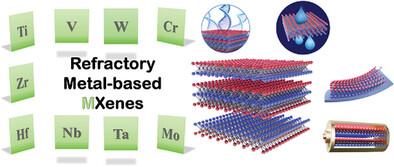Refractory Metal-Based MXenes: Cutting-Edge Preparation and Applications
IF 13
2区 材料科学
Q1 CHEMISTRY, MULTIDISCIPLINARY
引用次数: 0
Abstract
Refractory metal-based MXenes refer to MXenes with M as a refractory metal. Due to their high conductivity, large specific surface area, multiple active sites, high photothermal conversion efficiency, adjustable surface groups, and controllable nanolayer spacing, they hold broad application prospects in various fields such as photoelectrocatalysis, biomedicine, water treatment, electromagnetic shielding, and sensors. The unique physical properties of refractory metal-based MXenes are related to their electronic and crystal structures. The interstitial layer causes the carbides to exhibit different behavior compared to the original metal. At the same time, different preparation methods have a great influence on the interlayer spacing and surface termination of refractory metal-based MXenes, thus affecting their performance. This review systematically summarizes the latest progress in the preparation methods and frontier applications of refractory metal-based MXenes, offering new insights for further development. Additionally, various characterization techniques and first-principles calculations are summarized, which are crucial for optimizing refractory metal-based MXenes for applications such as catalysis, energy storage, and sensors. In summary, the current challenges and future development prospects of refractory metal-based Mxenes are addressed, aiming to provide indispensable information for the intelligent design of 2D materials in the future.

难熔金属基 MXenes:尖端制备和应用
难熔金属基 MXenes 是指以 M 为难熔金属的 MXenes。由于具有高导电性、比表面积大、活性位点多、光热转换效率高、表面基团可调、纳米层间距可控等特点,它们在光电催化、生物医药、水处理、电磁屏蔽和传感器等多个领域有着广阔的应用前景。难熔金属基 MXenes 的独特物理性质与其电子结构和晶体结构有关。与原始金属相比,间隙层使碳化物表现出不同的行为。同时,不同的制备方法对难熔金属基 MXenes 的层间间隔和表面终止有很大影响,从而影响其性能。本综述系统地总结了难熔金属基 MXenes 的制备方法和前沿应用方面的最新进展,为进一步开发提供了新的见解。此外,还总结了各种表征技术和第一原理计算,这对于优化难熔金属基 MXenes 在催化、储能和传感器等领域的应用至关重要。总之,本文探讨了难熔金属基 MXenes 目前面临的挑战和未来的发展前景,旨在为未来二维材料的智能设计提供不可或缺的信息。
本文章由计算机程序翻译,如有差异,请以英文原文为准。
求助全文
约1分钟内获得全文
求助全文
来源期刊

Small
工程技术-材料科学:综合
CiteScore
17.70
自引率
3.80%
发文量
1830
审稿时长
2.1 months
期刊介绍:
Small serves as an exceptional platform for both experimental and theoretical studies in fundamental and applied interdisciplinary research at the nano- and microscale. The journal offers a compelling mix of peer-reviewed Research Articles, Reviews, Perspectives, and Comments.
With a remarkable 2022 Journal Impact Factor of 13.3 (Journal Citation Reports from Clarivate Analytics, 2023), Small remains among the top multidisciplinary journals, covering a wide range of topics at the interface of materials science, chemistry, physics, engineering, medicine, and biology.
Small's readership includes biochemists, biologists, biomedical scientists, chemists, engineers, information technologists, materials scientists, physicists, and theoreticians alike.
 求助内容:
求助内容: 应助结果提醒方式:
应助结果提醒方式:


